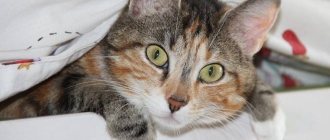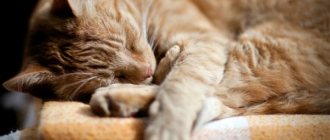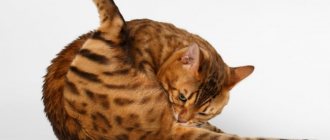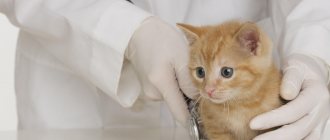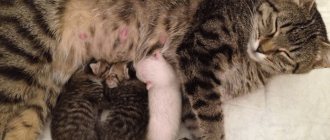Hyperparathyroidism in cats is a disease associated with a metabolic disorder (metabolic process), when calcium is washed out of bone tissue and enters the bloodstream. In accordance with the physiological norm, 99% of its volume is contained in the structures of the skeleton and tooth enamel, and the remaining 1% is present in the form of ions in the blood. With hyperparathyroidism, the balance is disrupted, which causes pathological changes in the body. Read more about the symptoms and treatment of this disease in our article.
Hyperparathyroidism in cats: symptoms and treatment
Hormones affecting calcium balance
The optimal amount of minerals in the blood, including calcium, is ensured by the action of hormones. One of these is parathyroid hormone, which is synthesized by the parathyroid organ. Under its influence, the calcium needed by the body is borrowed from the bones, and the kidneys begin to work to maximize the retention of these ions.
Mineral imbalance is followed by deterioration in well-being
The thyroid gland produces calcitonin, a specific hormone that has the opposite effect, thereby maintaining a healthy mineral balance. An incorrect balance can have detrimental consequences for your pet's health.
Adjuvant therapy
If a sick cat is obese, he must be put on a diet (approved by a veterinarian, of course). This is especially important for older animals.
Important! There is no need to completely deprive your pet of food, as this will lead to exactly the opposite results.
Specially designed “joint” diets are recommended. Their components contain combinations of essential fatty acids (EFAs), which serve to reduce inflammation and glycosaminoglycans (such as glucosamine and chondroitin).
The latter are part of cartilage. Supplements of this type are completely safe for the animal.
The problem is that veterinary practitioners are very leery of oral supplements.
In any case, they are not used as the main therapy: diet is used only as an additional therapeutic technique. In general, the use of agents injected directly into the joint is recommended.
I would like to note that in the most severe and advanced cases of joint disease in cats, they are treated using synthetic prostheses. If the joint has undergone degenerative changes, only implants can restore mobility and maintain a more or less high quality of life for the animal.
In order for the animal to recover, it is necessary to adjust its diet. If the kitten eats dietary foods, improvements are observed on the 6-7th day.
The veterinarian recommends specialized foods with calcium, phosphorus, protein, and fats. Some breeders do not agree to feed ready-made formulas; however, special nutrition is required.
After this, the kitten will be able to switch to natural food. If the owner categorically refuses to feed him with store-bought food, the doctor prepares a diet.
The kitten must eat foods recommended by the doctor.
With nutritional hyperparathyroidism, it is necessary to limit the animal’s mobility, this way it will be possible to prevent fractures. It is recommended to keep the kitten in a cage.
Treatment for hyperparathyroidism requires medications. The doctor prescribes a solution of calcium gluconate 10%.
If the disease reaches advanced stages, synthetic Calcitonin is prescribed. The drug restores bone structures and reduces the severity of pain.
Animals require mineral supplements. Young animals should receive 200 mg of calcium per 1 kg of weight.
Mineral feed is introduced into the diet.
Hyperparathyroidism is dangerous to the health of the animal; with this disease, the bones are severely affected. Analgesics and non-steroidal anti-inflammatory drugs are not used for treatment.
To avoid hyperparathyroidism, your kitten should be fed properly. Food with an optimal content of phosphorus and calcium is recommended.
Be sure to buy age-appropriate food. If the cat (or kitten) eats regular food, vitamin and mineral supplements should be added.
Unusual behavior of a pet should alert the owner. At the first symptoms of hyperparathyroidism, you should show the animal to a doctor.
If treatment is started in a timely manner, the prognosis of the disease can be improved.
What happens in the body when there is calcium deficiency?
Calcium deficiency leads to a decrease in its volume in the blood, which, in turn, stimulates the active production of parathyroid hormone. It promotes the active removal of the mineral from natural storage (i.e. skeletal bones) and its transfer into the blood to maintain its normal composition.
Phosphorus oversaturation occurs in cats that often eat fish.
In this case, the bones are destroyed without having time to recover. They become weak and fragile. When an animal's diet is oversaturated with phosphorus, the problem worsens, since this trace element (if there is too much of it) interferes with the normal absorption of calcium from the intestines.
Symptoms of eclampsia in cats
Animals of different breeds and ages are susceptible to the disease.
Risk group:
- first birth
- eclampsia during a previous birth
- multiple pregnancy
- age animal
- calcium imbalanced diet
- using a drug that lowers calcium levels in the blood.
Symptoms of the disease in cats:
- General condition: depression, fever, rapid breathing and cardiac arrhythmia. The mucous membranes and conjunctiva are pale. There is drooling and refusal to feed.
- Behavioral disorder: the animal rubs its muzzle with its paw, a state of anxiety turns into excitement or vice versa, inhibition. The cat begins to bite the kittens, drag them from one place to another, or leaves the offspring. The animal ceases to recognize its owner. In severe cases, loss of consciousness occurs.
- The appearance of cramps - sudden painful and involuntary muscle contractions. They can begin with a slight twitching of the muscles on the face and paws, and in severe cases they become prolonged. The animal takes unnatural positions, and numbness in certain parts of the body may occur. In extreme cases, the animal falls on its side, movements become constrained or, conversely, abrupt. Loss of coordination occurs.
Diet for a cat with hyperparathyroidism
The range of well-known food brands always includes products intended for animals with health problems.
Table. Ready-made food for animals with kidney pathology
| Name | Characteristic |
ADVANCE Cat Renal (Spain) | Therapeutic diet for cats with kidney disease. Complete and balanced composition for animals with poorly functioning kidneys and calcium deficiency. Prevents the formation of stones. Features low phosphorus content and high quality proteins |
| Hill's Feline j/d (USA) | Composition for cats with bone and joint problems. Normalizes their functionality in 1 month. Contains the optimal amount of nutrients, as well as beneficial omega-3 fatty acids |
| Royal Canin Mobility for cats and cats (France) | A complete product with chondroprotectors that improves the mobility of animal joints after injuries and operations, as well as for diseases of the musculoskeletal system |
| Pro Plan Veterinary Diets Feline NF Renal Function dry (Italy) | Medicinal composition for adult and old cats and cats, regardless of breed, all breeds with chronic renal failure and its complications |
| Pro Plan NF ST/OX RENAL FUNCTION (Italy) | Ready-made food for cats containing a small amount of dietary phosphate. Inhibits the development of renal failure and significantly reduces the incidence of secondary hyperparathyroidism |
It is important to understand that:
- in the fight against hyperparathyroidism and its manifestations, diet has medicinal value, which means it must be selected individually;
The diet for hyperparathyroidism is developed with the participation of a veterinarian
- some formulations are intended for constant feeding, others should be given for a limited time and in strictly defined quantities;
- There are therapeutic foods that are sold by prescription. But, even if the product can be purchased freely, its use should be previously agreed with a veterinarian.
The needs for minerals and other important components are different between young and old cats. When choosing a ready-made diet for a sick animal, you should take into account its age.
Treatment of eclampsia in cats
Emergency treatment of eclampsia in cats! Essentially, the body finds itself in a vicious circle: calcium is needed, but it is not in reserves. The animal develops a serious condition, there is no appetite, so calcium is not supplied with food. The only way out is to administer medications containing calcium. If assistance is not provided, the death of the animal can occur 12 hours after the first attack from heart failure. But with early treatment, the prognosis is favorable.
Treatment can only be prescribed and carried out by a veterinary specialist, approximately according to the following scheme:
- If signs of the disease appear in late pregnancy, a cesarean section is indicated.
- Immediate administration of drugs containing calcium and monitoring of heart function are mandatory. Subsequently, these drugs are used for 7-10 days, and additional therapy is prescribed based on the patient’s condition.
- If the disease manifests itself in a nursing cat, then the kittens are isolated, at least for a day, and are given artificial feeding. The cat itself is placed in a dark room with a calm environment.
In order not to put the animal at risk, it is necessary to carefully monitor the general condition. If the first signs of eclampsia appear, consult a doctor immediately.
Consequences of hyperparathyroidism
This pathology rarely goes away without a trace for the animal. Common consequences include:
- disturbances in the functioning of the central nervous system if the spine is deformed. They are expressed by paralysis and paresis, difficulties with bowel movements, urinary incontinence;
Urinary incontinence can become chronic
- curvature of the limbs, making the animal’s movement uncomfortable and painful;
- deformations of the pelvic bones and chest, which negatively affects the functioning of the cardiovascular, respiratory, digestive and genitourinary systems;
- dental problems;
Caries, pulpitis and even tooth loss are common in cats suffering from calcium deficiency.
- slow growth of the animal.
The earlier hyperparathyroidism is detected and the sooner treatment is started, the greater the cat’s chances of full recovery.
Secondary
Secondary hyperparathyroidism is called juvenile osteopathy. It occurs due to a lack of calcium. Also, it may appear after certain illnesses:
- destructive kidney damage;
- chronic dystrophic changes in the small intestine.
Important! As sad as it may be, primary hyperparathyroidism is much more common.
There are several types of this form of the disease, namely: nutritional and renal.
Nutritional
The nutritional type occurs due to improper nutrition, that is, it is provoked by the owner himself.
A balanced diet specially formulated for cats will have calcium and phosphorus levels in the correct (healthy) ratio. If a person feeds the animal “from the table,” then problems arise with the content of these substances in the body and, in the future, hyperparathyroidism develops.
Important!
The disease develops rapidly due to feeding the cat meat or dairy foods.
These products contain several times more phosphorus than calcium. This provokes the development of the disease.
Diagnosis and symptoms
Diagnosing the disease is quite simple since the symptoms of the disease are very pronounced, but owners sometimes do not pay attention to their pets. Most often, hyperparathyroidism is discovered in the clinic due to some kind of injury. For example, a broken limb, and the animal does not have to fall from a great height. At this stage, it is enough to jump from a height of half a meter.
Attention!
To determine the disease, blood collection will be required.
Symptoms:
- hypersoreness;
- tooth loss;
- softening of the jaw (becomes soft to the touch).
Due to the fact that the pet feels pain and aching bones, he refuses to run and play. Often shows aggression while stroking. Spends a lot of time lying or sitting, while looking constantly lethargic.
Peculiarities
A feature of the disease is a genetic predisposition. Siamese and British cats are most often affected.
Treatment
Treatment involves proper, balanced nutrition with a low phosphorus content and, of course, the use of medications.
Important!
Medicines are prescribed by the doctor based on the patient’s tests!
Renal
Renal hyperparathyroidism develops in those individuals who have kidney problems. With this form, the phosphorus content in the blood increases, and calcium, on the contrary, decreases. Diagnosis and symptoms The disease can be diagnosed by symptoms:
- dehydration;
- polyuria (increased urine production);
- polydipsia (unquenchable thirst);
- weakness;
- vomit;
- loss of appetite;
- lameness in various limbs.
However, a doctor must make an accurate diagnosis and prescribe treatment. Diagnosis is carried out in the clinic. For this we use:
- visual inspection;
- X-ray.
On x-rays, bones are most often barely visible. They become depleted and become transparent. The older and heavier the pet, the more serious the consequences can be.
Peculiarities
Features of the disease are:
- constipation;
- heart problems;
- problems with cardiac activity;
- limb failure.
Treatment
Here, treatment also begins with drawing up the right diet, and further actions depend on what tests are performed. The cat will need either drug treatment and mineral supplements, or surgical intervention.
Prevention
To protect your pet from hormonal pathology, which can lead to irreversible consequences, you must:
- take care of his proper nutrition, the best option for which would be the use of balanced ready-made feed;
The best option for a cured pet would be specialized premium food.
- Periodically show your cat to a veterinarian in order to have objective information about the state of its health, and, if necessary, also receive professional advice on diet and maintenance.
Prevention is the simplest and most inexpensive way to protect an animal from diseases and prolong its life. Owners of pets with hyperparathyroidism should take note of a balanced diet, which will help protect their pet from an excess of a particular substance in the body.
Natural cat diet
Diagnostics
To make a diagnosis, a survey of the owner is carried out, as a result of which an imbalance in the diet is discovered. Such kittens are usually fed natural products - cereals, meat, baby meat puree or industrial food, which does not contain information that the food is suitable for everyday feeding (a complete diet), which are not able to fully supply the kitten’s body with minerals, and are not balanced in phosphorus and calcium levels. To confirm nutritional hyperparathyroidism, an x-ray is taken, in which the animal has a noticeable decrease in bone density, pathological fractures, curvature of the spine, and tail creases are often visualized.

